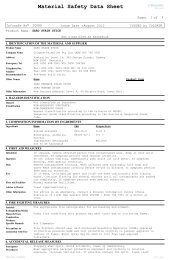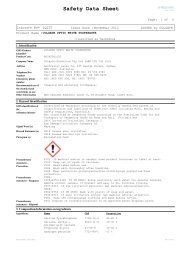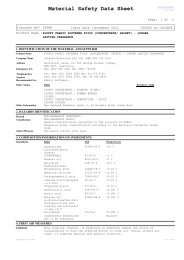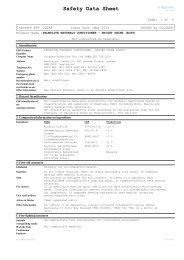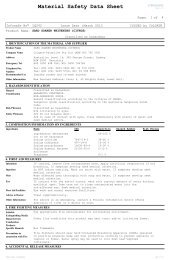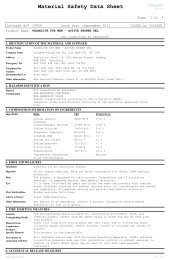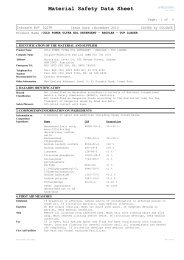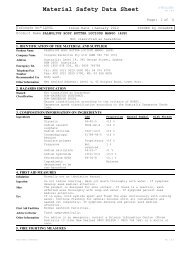Colgate Sensitive Pro-Relief
Colgate Sensitive Pro-Relief
Colgate Sensitive Pro-Relief
Create successful ePaper yourself
Turn your PDF publications into a flip-book with our unique Google optimized e-Paper software.
Material Safety Data Sheet<br />
CS: 1.4.93<br />
Page: 2<br />
of<br />
4<br />
Infosafe No LPZ6L Issue Date : July 2010 ISSUED by COLGATE<br />
<strong>Pro</strong>duct Name :COLGATE SENSITIVE PRO-RELIEF - [MASS MARKET]<br />
Precautions in<br />
connection with Fire<br />
Fire fighters should wear Self-Contained Breathing Apparatus (SCBA) operated<br />
in positive pressure mode and full protective clothing to prevent exposure to<br />
vapours or fumes. Water spray may be used to cool down heat-exposed<br />
containers.<br />
6. ACCIDENTAL RELEASE MEASURES<br />
Emergency<br />
<strong>Pro</strong>cedures<br />
7. HANDLING AND STORAGE<br />
Precautions for Safe<br />
Handling<br />
Conditions for Safe<br />
Storage<br />
Corrosiveness<br />
Slippery when spilt. Avoid accidents, clean up immediately.<br />
Small spill: Mop up & wash residue to drain with copious amounts of water.<br />
Large spill: Contain and place absorbent material such as vermiculite, sand or<br />
dirt onto spillage. Collect and place into a suitable labelled container.<br />
Clean area with soap and water, collect residue and place into the same<br />
container. If large quantities of this material enter the waterways contact<br />
the Environmental <strong>Pro</strong>tection Authority, or your local Waste Management<br />
Authority.<br />
Avoid eye contact. In the work environment: wear appropriate protective<br />
equipment to prevent exposure. Prevent the creation of vapours or mists in the<br />
work atmosphere and ensure adequate ventilation. Keep containers closed when<br />
not in use. Practice good personal hygiene, that is, always wash hands after<br />
handling, and before eating, drinking, smoking or using the toilet facilities.<br />
Store in a cool, dry well-ventilated area away from heat and out of direct<br />
sunlight. Avoid contact with incompatible materials, such as those that<br />
support combustion, including strong oxidising agents. Keep containers closed<br />
when not in use and securely sealed and protected against physical damage.<br />
Inspect regularly for deficiencies such as damage or leaks.<br />
Not corrosive to metals.<br />
8. EXPOSURE CONTROLS/PERSONAL PROTECTION<br />
National Exposure<br />
Standards<br />
Biological Limit<br />
Values<br />
Engineering<br />
Controls<br />
Respiratory<br />
<strong>Pro</strong>tection<br />
Eye <strong>Pro</strong>tection<br />
Hand <strong>Pro</strong>tection<br />
Body <strong>Pro</strong>tection<br />
No exposure standards have been established for the mixture by the National<br />
Occupational Health & Safety Commission (NOHSC). However, over-exposure to<br />
some chemicals may result in enhancement of pre-existing adverse medical<br />
conditions and/or allergic reactions and should be kept to the least possible<br />
levels.<br />
No biological limits allocated.<br />
No special engineering controls required. However, under industrial<br />
applications, provide sufficient ventilation to keep airborne levels as low as<br />
possible. Where vapours or mists are generated and exposure standards are<br />
exceeded, the use of respiratory protection, or a local exhaust ventilation<br />
system is recommended.<br />
Not required under normal conditions of use.<br />
Industrial Applications: If engineering controls are not effective in<br />
controlling airborne exposure then respiratory protective equipment should be<br />
used suitable for protecting against airborne contaminants. Final choice of<br />
appropriate breathing protection is dependant upon actual airborne<br />
concentrations and the type of breathing protection required will vary<br />
according to individual circumstances. Expert advice may be required to make<br />
this decision. Reference should be made to Australian Standards AS/NZS 1715,<br />
Selection, Use and maintenance of Respiratory <strong>Pro</strong>tective Devices; and AS/NZS<br />
1716, Respiratory <strong>Pro</strong>tective Devices.<br />
Not required. However, avoid eye contact.<br />
Industrial Applications: The use of safety glasses as appropriate when<br />
handling large quantities. Refer to Australian Standard AS/NZS 1337 - Eye<br />
<strong>Pro</strong>tectors for Industrial Applications.<br />
The use of PVC or nitrile rubber gloves recommended when handling large<br />
quantities of this material.<br />
Not required under normal conditions of use.<br />
Industrial Applications: Suitable impervious protective clothing.<br />
9. PHYSICAL AND CHEMICAL PROPERTIES<br />
Appearance<br />
Odour<br />
White paste<br />
Not available<br />
Print Date: 23/07/2010 CS: 1.4.93



